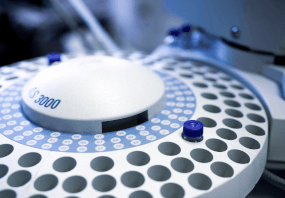Purpose of derivatization Improved volatility, better thermal stability or a lower limit of detection in GC Prerequisite: quantitative, rapid and reproducible formation of only one derivative Halogen atoms introduced by derivatization (e.g., trifluoroacetates) for specific detection (ECD) with the advantage of high sensitivity Influence of elution orders and fragmentation patterns in MS by a specific derivatization Methylation reagent DMF-DMA Methylation with DMF-DMA can be applied for fatty acids, primary amines and (partially) amino acids forming N-dimethyl-aminomethylene amino acid methyl esters. DMF-DMA is a poor solvent, for this reason it is necessary to use a mixture of DMF-DMA with pyridine, THF, acetone (barbiturates) or another solvent. Methylation reagent TMSH Methylation with TMSH is recommended for free acids, chlorophenoxycarboxylic acids, their salts and derivatives as well as for phenols and chlorophenols. One great advantage is simplification of the sample preparation. Lipids or triglycerides can be converted to the corresponding fatty acid methyl esters (FAMEs) by a simple transesterification. This reaction is very elegant and convenient, because it is just necessary to add the reagent (0.2 M in methanol) to the sample solution. Removal of excess reagent is not required, since in the injector of the gas chromatograph at 250 °C pyrolysis to volatile methanol and dimethylsulfide will occur. Due to the high reactivity, complete derivatization is often obtained at ambient temperature. However, heating (e.g., 10 min at 100°C) in a closed sample vial may be necessary. These products can contain harmful substances which must be specially labeled as hazardous.
Shipping Information:
Hazmat Fee: $65.00 + applicable shipping charges are added after the order is placed.
More Information: https://cenmed.com/shipping-returns
- UPC:
- 51111909
- Condition:
- New
- Availability:
- 3 Days
- Weight:
- 1.00 Ounces
- HazmatClass:
- Yes
- WeightUOM:
- LB
- MPN:
- 701430.201












